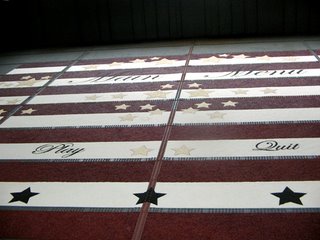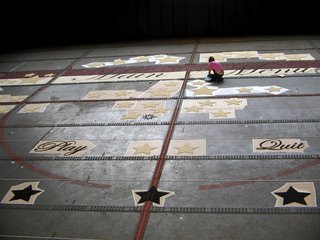
Una feria es una feria es una feria.
Lo importante es descubrir las diferencias y saber donde esta uno... Aparte interesante toda la construccion y marana que es sostenida por la obra. Igual no me puedo quejar, comparti con artistas que aprecio mucho como Federico Herrero, Sally Smart y Clemencia Labin.
Tuve la suerte de ser nombrada en el NYTimes del 10 de diciembre, en la seccion Fashion and Style -sorpresa:
Fashion & Style
Miami Basel: An Art Costco for Billionaires
Little about art collecting as a competitive high stakes game may be new. Yet the broadening of the consumer base is, and so is the inescapable truth that the trade is now substantially driven by marquee auctions and art fairs that come to feel like circuit parties for the ultrarich. The profile of an average conventioneer at Miami Basel can perhaps be deduced from the number of private jets leased to fly here this week. NetJets alone - to name a leading vendor of shared jet ownership - booked 216 flights to Miami for this year's fair, a 44 percent increase over two years ago."I'm just making the first round," said Beth Rudin DeWoody, the philanthropist and collector, on Wednesday as she power-walked the aisles of the main fair, scattering in her path the red dots that signify a work has been sold. At one booth a young California couple was mulling the purchase of a picture by the hot Kenyan artist Wangechi Mutu. "How much are you asking?" the husband inquired. "Sixty," said the dealer, meaning $60,000. "Is that the only one you have?" the woman asked. "We have room in our den for two."Who knows if the Mutu was not a steal? It was big, and that is important to collectors who now inhabit houses the size of department stores. "Well, it's not Bergdorf's," said the Texas collector Becca Cason Thrash, who had just bought a Tony Cragg sculpture of heads for her 21,000-square-foot Houston mansion, where 300 can be seated for dinner. "More like a boutique."Certainly Ms. Mutu's art was far from the costliest stuff around in a fair at which a rare Blue Period Picasso was among the choicer offerings. "Crazy zeros" is how one longtime collector termed current art pricing. Pull a figure out of a hat and add a random aught or two. "There are all these things that have no established secondary market," remarked the architect and collector David M. Schwartz, who flew down on his private jet from Washington, as much to steal a long weekend at his 11-bedroom Miami Beach house as to glissade through the hectic social scene. "What do you do in a couple of years when the stuff is worth nothing?" he remarked. You give it to a museum and then call the I.R.S.In a chauffeur-driven S.U.V. the size of a studio apartment, Mr. Schwartz ventured out with a posse of guests on Wednesday evening, stopping first at a party the real estate developer Craig Robins gave for the artist Guillermo Kuitca. Mr. Kuitca was unveiling "Aquarelle," a reflecting pool he created at Aqua, Mr. Robins's multimillion dollar residential development, where curb appeal has been ratcheted up with art. Richard Tuttle, for instance, installed a tiled sculpture on two poolside walls there, the tiles meant to represent a splash pattern created by a boulder dropped into the pool. The price tag is reputed to be no drop in the bucket, perhaps as much as $2 million. Mr. Kuitca's creation is a tiled depression, whose ornamentation looked like a Google Earth view of the Aqua vicinity. As the crab salad tarts were passed in the cool tropical evening and Mr. Robins showed a Shanghai investor around the place, it suddenly came clear that what the Kuitca pool most resembled, set as it was in a moat of shredded rubber mulch the artist found on eBay, was a fancy version of the tub planters one sometimes sees in rural yards. "Did you see the, uh, what was it, the rice and beans thing?" a billionaire was overheard asking later at a dinner that Tamara Mellon, the founder of the cult shoe company Jimmy Choo, gave at David Bouley Evolution. The artwork to which the man was alluding was an installation by the Costa Rican artist Lucia Madriz, a welcome mat formed of rice with a cursive inscription made using the medium of dried beans. Especially given the context, the legend on the mat - "Money Talks" - seemed beyond dispute. But as Ms. Mellon's guests tucked into lobster with vanilla-glazed turnips and parsley swirls, it struck one observer that Ms. Madriz's critique was so gentle as to be almost quaint. Since when do wealth and power settle for mere chatter? Money doesn't just talk anymore. Money screams.
Lo importante es descubrir las diferencias y saber donde esta uno... Aparte interesante toda la construccion y marana que es sostenida por la obra. Igual no me puedo quejar, comparti con artistas que aprecio mucho como Federico Herrero, Sally Smart y Clemencia Labin.
Tuve la suerte de ser nombrada en el NYTimes del 10 de diciembre, en la seccion Fashion and Style -sorpresa:
Fashion & Style
Miami Basel: An Art Costco for Billionaires
Little about art collecting as a competitive high stakes game may be new. Yet the broadening of the consumer base is, and so is the inescapable truth that the trade is now substantially driven by marquee auctions and art fairs that come to feel like circuit parties for the ultrarich. The profile of an average conventioneer at Miami Basel can perhaps be deduced from the number of private jets leased to fly here this week. NetJets alone - to name a leading vendor of shared jet ownership - booked 216 flights to Miami for this year's fair, a 44 percent increase over two years ago."I'm just making the first round," said Beth Rudin DeWoody, the philanthropist and collector, on Wednesday as she power-walked the aisles of the main fair, scattering in her path the red dots that signify a work has been sold. At one booth a young California couple was mulling the purchase of a picture by the hot Kenyan artist Wangechi Mutu. "How much are you asking?" the husband inquired. "Sixty," said the dealer, meaning $60,000. "Is that the only one you have?" the woman asked. "We have room in our den for two."Who knows if the Mutu was not a steal? It was big, and that is important to collectors who now inhabit houses the size of department stores. "Well, it's not Bergdorf's," said the Texas collector Becca Cason Thrash, who had just bought a Tony Cragg sculpture of heads for her 21,000-square-foot Houston mansion, where 300 can be seated for dinner. "More like a boutique."Certainly Ms. Mutu's art was far from the costliest stuff around in a fair at which a rare Blue Period Picasso was among the choicer offerings. "Crazy zeros" is how one longtime collector termed current art pricing. Pull a figure out of a hat and add a random aught or two. "There are all these things that have no established secondary market," remarked the architect and collector David M. Schwartz, who flew down on his private jet from Washington, as much to steal a long weekend at his 11-bedroom Miami Beach house as to glissade through the hectic social scene. "What do you do in a couple of years when the stuff is worth nothing?" he remarked. You give it to a museum and then call the I.R.S.In a chauffeur-driven S.U.V. the size of a studio apartment, Mr. Schwartz ventured out with a posse of guests on Wednesday evening, stopping first at a party the real estate developer Craig Robins gave for the artist Guillermo Kuitca. Mr. Kuitca was unveiling "Aquarelle," a reflecting pool he created at Aqua, Mr. Robins's multimillion dollar residential development, where curb appeal has been ratcheted up with art. Richard Tuttle, for instance, installed a tiled sculpture on two poolside walls there, the tiles meant to represent a splash pattern created by a boulder dropped into the pool. The price tag is reputed to be no drop in the bucket, perhaps as much as $2 million. Mr. Kuitca's creation is a tiled depression, whose ornamentation looked like a Google Earth view of the Aqua vicinity. As the crab salad tarts were passed in the cool tropical evening and Mr. Robins showed a Shanghai investor around the place, it suddenly came clear that what the Kuitca pool most resembled, set as it was in a moat of shredded rubber mulch the artist found on eBay, was a fancy version of the tub planters one sometimes sees in rural yards. "Did you see the, uh, what was it, the rice and beans thing?" a billionaire was overheard asking later at a dinner that Tamara Mellon, the founder of the cult shoe company Jimmy Choo, gave at David Bouley Evolution. The artwork to which the man was alluding was an installation by the Costa Rican artist Lucia Madriz, a welcome mat formed of rice with a cursive inscription made using the medium of dried beans. Especially given the context, the legend on the mat - "Money Talks" - seemed beyond dispute. But as Ms. Mellon's guests tucked into lobster with vanilla-glazed turnips and parsley swirls, it struck one observer that Ms. Madriz's critique was so gentle as to be almost quaint. Since when do wealth and power settle for mere chatter? Money doesn't just talk anymore. Money screams.

